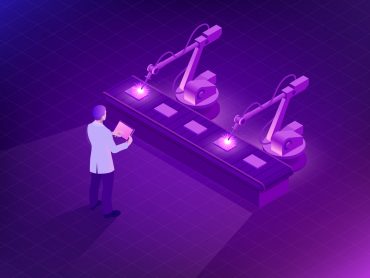
Implementing large language models and AI into your automation project is just a small part of making sure it is a big success.
ChatGPT has had a major influence on business operations globally, with many companies even re-evaluating their digital transformation strategies to encompass new forms of generative AI.
However, business leaders must be careful not to shoot themselves in the foot by jumping on the generative AI bandwagon too quickly.
Yes, generative AI – or large language models – can certainly play a role in your intelligent automation journey, but there are other important factors to consider to ensure your plan is a success.
Here are four common mistakes tech leaders make when leading a digital transformation project:
1) Lack of clear vision: Despite increasing investments in automation, analysts report that many deployments continue to fail at alarmingly high rates. A study showed the top reason cited for projects being unsuccessful was ‘vague automation goals,’ according to 43% of respondents in the USA (24% globally). In essence, business leaders don’t really know what they are trying to accomplish.
Yes, higher revenue and cost savings may be obvious objectives, but it needs to go deeper than that. It’s important to clearly pinpoint the expected outcomes – such as improving customer experience, increasing operational efficiency, retaining employees, attracting more customers, or expanding into new markets.
Those responsible for driving and overseeing the transformation must be a cross-functional team with members of staff from IT operations, marketing, sales, customer service and other relevant departments to ensure you get an inclusive view. That way, you can focus on projects that align with everyone’s objectives and identify areas where digitalization can have the most impact and best ROI. This will involve conducting an assessment of current operations to evaluate the existing technology infrastructure, processes, and systems to distinguish strengths, weaknesses, and opportunities.
Even then, however, you may hit a sticking point, which brings me to my next point.
2) Not fully understanding current processes: The problem with garnering employee feedback is that people’s opinions will vary and, depending on their role, may be biased – and perhaps not even accurate.
This has led to some organizations investing heavily in automation only to discover that they automated the WRONG area. Automating the incorrect aspects of a workflow can have direct adverse effects on outcomes, such as delaying a back-end bottleneck until it is more visible to the customer rather than eliminating it altogether.
It is, therefore, crucial to establish a data-driven decision-making process by implementing analytics tools to gather insights and inform strategic decisions.
The rise of such analytics technology, driven by artificial intelligence and machine learning, has enabled businesses to understand their own processes and operations more thoroughly – before moving forward with change.
One such technology is process intelligence, which combines task mining and process mining to depict an accurate and detailed model of a workflow in real time to better identify opportunities for automation. Task mining focuses on employees’ micro-interactions like keystrokes and mouse clicks that occur while completing tasks, while process mining examines event logs and behind-the-scenes movements throughout the larger process.
Process intelligence is like having a digital twin of your entire company workflow so you can visualize exactly how everyone and everything operates and comes together in real time. You can see where things work well and where they don’t, understand why there are blockages or delays, and compare how each employee completes tasks so you can address pain points and make appropriate changes.
IT leaders can use these insights to guide the implementation of new solutions and/or resources and take a clearer path toward successful, intelligent automation.
See also: In an Age of Hyper Automation, Most Tech Problems are Still Fixed Manually
3) Too technology-focused: You only have to look at the uptake of ChatGPT to see that organizations can get wrapped up in the latest technology without fear of being left behind.
Vendors can be clever at selling fancy software that promises to make your organization faster, better, and more efficient. However, is it user-friendly, does it solve a true business problem, and, more importantly, customer-focused?
Research shows that almost a third of organizations (29%) blamed the failure of their automation project on being ‘overpromised on the technology.’ In addition, a further 37% put the failure down to employees not receiving enough training from the vendor.
Don’t underestimate the importance of selecting partners that can provide the solutions and expertise you need, which include software providers, consultants, and systems integrators.
But remember, even the best apps have been discarded because people simply don’t like using them. It’s important to look at the impact on employees and customers. Humans are generally averse to change, and if they do have to endure it, then they must see the true value in it – such as being easier to use, more convenient, providing faster service, and allowing more time for other important tasks. The research confirmed this with the top reason given for digital transformation projects being successful, ‘the automation technology was as easy to use as promised.’ This further underlines the importance of harnessing employee buy-in.
4) Unable to measure success and make adaptations: Automation is never a one-and-done job; it is a continuous digital transformation journey. You must be able to define milestones, timelines, and key performance indicators (KPIs) to track progress.
Agility and scalability are essential. Teams must be flexible and able to adapt quickly to shifting priorities, customer feedback, and market demands. This enables organizations to stay competitive in rapidly changing environments.
So, how can you assess the success of your efforts, look for opportunities to innovate and improve, and, more importantly, be able to adjust or take corrective action?
In addition to process mining, which evaluates your processes in real time, advanced process simulation capabilities have predictive powers to allow decision makers to experiment with changes to workflows and resources to see the impact on overall operations. For example, they may wish to see the effect of adding more employees to a helpdesk to gauge how it will reduce wait times for ticket resolution. Or perhaps they want to find out what would happen if a certain step was completed at twice its current speed. It’s akin to a flight simulator. A prospective pilot can gain the experience needed to handle any situation or variable that might be encountered – inclement weather, equipment failure, refueling – without the risk of experiencing it firsthand. This forecasting ability enables organizations to be proactive in optimizing their workflows with highly specific variables in mind.
A final word of caution when using AI for automation
Considering that ChatGPT is now being used by almost half of companies globally while another 30% intend to use it in the future, there is no doubt that the growth of generative AI is changing the way we work. It is already being integrated with existing enterprise systems and workflows, allowing for seamless interaction and data exchange. However, it’s important to remember that digital transformation needs a broader, strategic, and analytical approach. Implementing large language models and AI into your automation project is just a small part of making sure it is a big success.




























